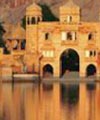|
Wildlife
Rajasthan is a heaven for a wide spectrum of wild life. On the
one part while you have desert land, the east is the green, fertile
land dotted with lakes thickly wooded and through which the beautiful
river Chambal flows. The jungles are alive with tiger, leopard,
black bucks, chinkara, the rare desert fox, the endangered caracal,
the great Indian bustard, gavial, monitor lizard, wild boars, Sambhar,
nilgai. Migratory birds like the common crane, ducks, coots, pelicans
and the rare Siberian cranes, falcons, buzzards, imperial sandgronse
flock to the state. On the onset of monsoon the jungles are lush
green, peacocks dance under every tree, the koel calls in the mango
groves. Rajasthan boasts of two National parks, over a dozen Sanctuaries
& two closed areas. All wildlife sanctuaries are  accessible
by car and all have accommodation within or near them. accessible
by car and all have accommodation within or near them.
Koeladeo Ghana National Park
Declared a National park in 1983, this 29-sq. km. park is the largest
bird sanctuary in Asia. The rich aquatic plant & animal life
in the shallow, freshwater marsh of Bharatpur ahs been attracting
residents & migrating birds in thousands since times immemorial.
The estate was converted into a bird sanctuary in 1956. Over 10,000
nests of egrets, darters, cormorants, Grey herons & stocks hatch
nearly 20,000 to 30,000 chicks every year. The rare near extinct
Siberian Cranes visit no other waters in India except the marshes
of Keoladeo, Mammals like Sambhar, black buck chital, niglai, fishing
cat, otter & mongoose also roam about freely here.
Sariska Tiger Reserve (Alwar)
The other tigerland in rajasthan, nearest from Delhi (190 km) &
Jaipur (107 km) is dominated by sharp cliffs of the hills and the
narrow valleys of the Aravallis. In this 480 sq. km. sanctuary the
grassy glades and woodland covers are excellent niches for the prey
species, sambhar, chital, nilgai, four horned antelope, wild boar
and common langur. One can easily count 200 peafowls at Kalighati
any day. The ruins of 9th temples of Garh-Rajor of the 10th &11th
centuries remind of the past glories of the area.
Darrah Sanctuary
Previously the hunting ground of the Kota Maharajas, this sanctuary
established in 1955 covering an area of 266 sq.km., 60 sq.km. from
Kota is hilly terrain with thick forests. The animals here include
wolf,  slothbear,
chinkara & leopard. slothbear,
chinkara & leopard.
Kumbhalgarh Sanctuary
The majestic fort of Kumbalgarh overlooks the 578 sq.km. sanctuary.
This is perhaps the only sanctuary, where Indian wolf is breeding
successfully. Mostly west of the fort the sanctuary also support
leopard, sloth, chowsingha, sambhar, hyena, flying squirrel, crocodiles
& a variety of birds. The monsoon brings on the attractive flora
& the autumn, russets colours. The tribals Bhils & Garasis
can be seen here, living in their traditional huts.
Ranthambhor National Park (Sawai Madhopur)
Iinitiated in 1973, identified major areas inhabited by tigers.
The national park is 14 km east of Sawai Madhopur Town covering
392 sq.km. area running from the easter mostspur of the Aravallis
to the Vindhya range with the approach along a narrow valley. Here
Sanbhar, chital, chinkara, nigai, wild boar and common langur provide
a spectrum of prey range for the resident tigers and their copredators
leopard & jackal. Sloth bear & hyena also live in this unique
habitat of dry decidulous forests.
Jai Samand Sanctuary
The man made lake spreading over 160 sq.km. is the biggest water
body of the region. It holds a sizeable population of crocdiles
and an enormous quantity of fish. Jaismand Sanctuary harbours sloth
bear, leopard, chital chinkaras, wild boar and variety of birds
in open forests on the adjoining hills.
Mt. Ab u
Sanctuary u
Sanctuary
Mt. Abu Sanctuary (289 sq.km.) established in 1960 provides shelter
to the common langur, wild boar, sambhar, leopard & grey jungle
fowl. Besides a number of flowering trees ( Dhak & Erythrina
) enhance the beauty of this place.
Desert National Park
Established in 1980, 30 km from Jaisalmer the park was created to
protect 3000 sq.km. of Thar Desert, the habitat for drought resistant,
endangered and rare species which have adjusted to the unique &
inhopitable conditions of extreme temperatures. The trees found
are mostly leafless and throny & often have very long roots
e.g. Khejri, Khair, Thor & Rohira.
Top
Information on wildlife tours, wildlife viewing, wildlife park and nature of Rajasthan - india
|







 accessible
by car and all have accommodation within or near them.
accessible
by car and all have accommodation within or near them.
 slothbear,
chinkara & leopard.
slothbear,
chinkara & leopard. u
Sanctuary
u
Sanctuary